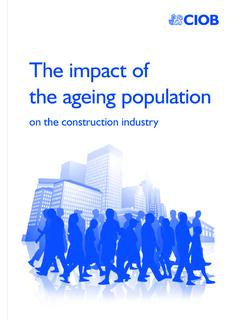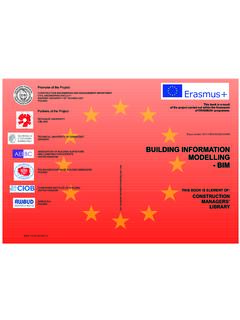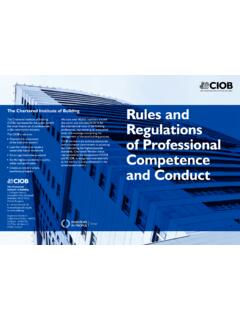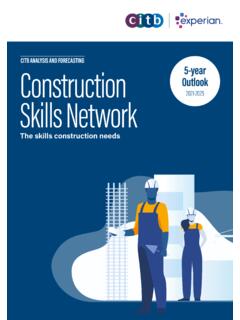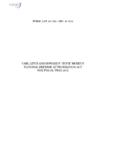Transcription of A REPORT EXPLORING PROCUREMENT IN THE …
1 The Chartered A REPORT EXPLORING PROCUREMENT . IN THE construction INDUSTRY. Institute of Building The Chartered Institute of Building (CIOB) represents for the public benefit the most diverse set of professionals in the construction industry. Our Mission: We have over 46,000. To contribute to the creation of a modern, progressive, members around the world and responsible construction industry; able to meet the economic, environmental and social challenges faced and are considered to be the in the 21st century. international voice of the building professional, representing an Our 7 Guiding Principles: unequalled body of knowledge n Creating extraordinary people through professional learning and continuous professional development. concerning the management n Promoting the built environment as central to of the total building process. the quality of life for everyone everywhere. Chartered Member status is recognised internationally n Achieving a sustainable future, worldwide.
2 As the mark of a true, skilled professional in the construction industry and CIOB members have a n Advocating exemplary ethical practice and common commitment to achieving and maintaining the behaviour, integrity and transparency. highest possible standards within the built environment. n Pursuing excellence in management practice, The Chartered Building Company and Consultancy and technological innovation rooted in Schemes (CBCs) are a vital part of the CIOB, providing the evidence based science. Institute's members with a further business perspective. n Being socially responsible and working responsibly. To find out more about the benefits of either individual n Enabling our members to find an emotional resonance CIOB membership or CBC schemes go to our website with the Institute; their success is our success. or call us on +44 (0)1344 630 700 today. Englemere, Kings Ride, Ascot Berkshire SL5 7TB, United Kingdom t: +44 (0)1344 630 700 f: +44 (0)1344 630 777.
3 E: w: Registered Charity 280795. The Chartered Institute of Building 2010. INTRODUCTION. INTRODUCTION. The Chartered Institute of Building is the leading INTRODUCTION P1 professional body for personnel in the global EXECUTIVE SUMMARY P3 construction management industry. Established BACKGROUND INFORMATION P4 in 1834, the CIOB continues to lead the way in CURRENT METHODS OF PROCUREMENT P4 establishing, promoting and maintaining standards THE ROLE OF THE CLIENT P8 of excellence in the sector. PUBLIC SECTOR AND VALUE FOR MONEY P10. SUICIDE BIDDING P12 The CIOB draws its members PROCUREMENT in the construction CONTENTS. COVER PRICING P13 from a wide range of professional industry through the views of RESULTS AND DISCUSSION P14 disciplines, from across the industry professionals. The CIOB. building and construction supply will use this research to raise METHODOLOGY AND DEMOGRAPHICS P14 chains. These include clients, the awareness in the public and METHODS OF PROCUREMENT P16 consultants and contractors, as political arenas of the issues PUBLIC SECTOR PROCUREMENT P21 well as specialists in regulation, surrounding PROCUREMENT in the CLIENTS IN construction P24 research and education.
4 Industry, including the effects of the recent spending review, and ADVERSE PRACTICES IN PROCUREMENT P26 The purpose of this research is to provide recommendations on CONCLUSIONS AND RECOMMENDATIONS P28 to investigate the perception of how best to overcome barriers. PROCUREMENT IN THE construction INDUSTRY 2010 PUBLISHED DECEMBER 2010 01. EXECUTIVE SUMMARY. This is first survey from the Chartered Institute of Building (CIOB) into PROCUREMENT in the construction industry. The key findings from this REPORT indicate that construction professionals view PROCUREMENT as absolutely crucial to the delivery of a project on time, on budget and to a high quality, with 87% of respondents of the belief that good PROCUREMENT is synonymous with a successful project. 82% of respondents believe that suicide bidding exists within the industry, a worrying statistic that highlights the dangers of selecting a very low bid at tender stage. This research examines the stance of construction these issues are closely linked industry professionals on the current state of into the need for the industry PROCUREMENT within the sector, with a particular to integrate further.
5 Focus on the UK industry. It centres on the role of the client, current methods of PROCUREMENT , Unsurprisingly, 78% of the effects of the spending cuts both now and respondents expect the EXECUTIVE SUMMARY. in the future, the prevalence of practices such Government spending cuts to as suicide bidding, and what can be done to result in a decrease of available improve construction PROCUREMENT practice. work. In terms of PROCUREMENT , 19% feel that the spending cuts The findings from this survey indicate that will actually increase the cost 77% of respondents believe clients are not of the PROCUREMENT process, sufficiently knowledgeable about PROCUREMENT compared to the 10% who in the construction industry, which often feel it will reduce the cost. leads to poor advice being taken and results in a project coming in over-budget, outside According to respondents, of timeframes, or to a poor standard. the four key priorities in public sector PROCUREMENT should be: 93% of respondents have been involved in projects Standardisation that overran in terms of cost.
6 57% of those who Reduced cost of PROCUREMENT had been involved in those projects believed Sustainability that the chosen PROCUREMENT method directly Public accountability contributed to the cost overruns. Similarly, 94%. have been involved on projects that overran in 64% of the sample believe terms of time. Of those, 49% believe the chosen a more transparent 78% OF RESPONDENTS PROCUREMENT method directly led to the time PROCUREMENT process will EXPECT THE overruns. Half of respondents indicate that a lack benefit the construction industry. GOVERNMENT of communication is the most significant problem Transparency will allow for arising during the PROCUREMENT process, followed more trust and openness spending CUTS TO by 46% who are of the belief that alterations to between all parties, therefore RESULT IN A DECREASE client requirements is a problem, and 34% who resulting in a greater emphasis OF AVAILABLE WORK highlighted issues over responsibility. All three of on communication.
7 02 PROCUREMENT IN THE construction INDUSTRY 2010 03. BACKGROUND INFORMATION CURRENT METHODS OF PROCUREMENT BACKGROUND INFORMATION CURRENT METHODS OF PROCUREMENT . Design and Build is popular with clients, as the risk primarily lies with the contractor and the process is relatively easy OF PROCUREMENT . PROCUREMENT is essentially a series to understand the project is specified to be designed (at of considered risks each method least in part) and built by the has individual strengths and same contractor, which, in design and construction stages. The prime weaknesses, which must be theory, allows for greater contractor is paid all actual costs, plus profits carefully calculated by clients and PROCUREMENT , being a series communication. Other parts of incurred in respect of measured work and of risks, has different methods the design phase may be carried design staff the main risk lies in respect of staff industry alike. There are a number that transfer varying levels out by consultants hired by the and the supply chain, including subcontractors.
8 Of different types of PROCUREMENT of risk onto the client or client, though the contractor will routes available for clients to select. contractor. The most used likely that the simplicity involved be informed of developments Private Finance Initiative/Public-Private Partnership Each different type of PROCUREMENT method, according to the in understanding Traditional is its during the phase. It is not Projects (PFI/PPP) has long been the subject of CURRENT METHODS. RICS Contracts in Use survey greatest strength the designer always as straightforward as debate as to its effectiveness. Launched in the (Traditional, Design and Build, (2007) 1 , is the Traditional is responsible for design and this, and there can be numerous mid-1990s by the then-Conservative Government, construction Management, etc) method of PROCUREMENT . the contractor for execution, so changes to the design in the PFI reached popularity under the Labour has its own advocates and inherent responsibility for co-ordination construction phase, or a lack Government between 1997 to 2010.
9 Designed strengths and weaknesses. Traditional contracting, which of subcontract packages lies of communication between the specifically for large-scale, high value projects such can be described as the firmly with the contractor. While two teams. Ideally, the Design as road/rail infrastructure networks or hospitals, Selection of an absolute optimal PROCUREMENT separation of design and complications will inevitably and Build stage would see both PFI is a result of the shift towards privatisation. method is difficult, because even the most construction using a lump-sum arise, as with any PROCUREMENT teams working in partnership, experienced client or contractor does not contract, has its weaknesses, system, the Traditional method with the contractors giving PFI differs in that, instead of paying a lump know all the potential benefits or risks for as all other methods of sees each party knowing feasibility input in the design sum upfront for a new project, the Government each method.
10 PROCUREMENT is, therefore, PROCUREMENT do. However, where they stand, and who stage, and the architect advising agrees to pay a private firm an annual fee a succession of calculated risks'. Industry the construction industry has has responsibility for what. on site during the construction over a set number of years to take on the entire and academia have consistently focused used the Traditional process for Weaknesses with Traditional are, phase. Both would result in a construction , financing, design, management on reducing this risk through the use of so long that it has become the however, apparent. The nature more integrated approach, as and operation of the project. The private firm innovative methods of PROCUREMENT . most understood. Indeed, it is of separating the design and set out in the Latham REPORT makes a profit on the fee, the Government avoids construction processes means Constructing the Team'. 2 administrative work, and this frees up resources The difficulty, and what sets construction industry disputes are common, and those in their departments for other use.



